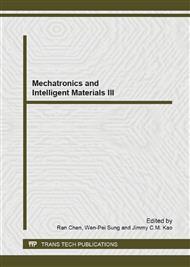[1]
Stuart Kyle, Amalia Aggeli, Eillen lngham and Michaael J.McPherson. Production of self-assembling biomaterials for tissue engineering [J]. Trends in Biotechnology, 2009, 27(7):423-434.
DOI: 10.1016/j.tibtech.2009.04.002
Google Scholar
[2]
Paola Brun, Francesca Ghezzo, Martina Roso, Roberta Danesin, Giorgio Palù, Andrea Bagno, Michele Modesti, Ignazio Castagliuolo and Monica Dettin. Electrospun scaffolds of self-assembling peptides with poly (ethylene oxide) for bone tissue engineering [J]. Acta Biomaterialia, 2011, 7:2526-2533.
DOI: 10.1016/j.actbio.2011.02.025
Google Scholar
[3]
Archana Mishra, Yihua Loo, Rensheng Deng, Yon Jin Chuah,Hwan Tak Hee, Jackie Y. Ying and CharlotteE.Hauser. Ultrasmall natural peptides self-assemble to strongtemperature-resistant helical fibers in scaffolds suitable for tissue engineering [J].nanotoday, 2011, 6:232-239.
DOI: 10.1016/j.nantod.2011.05.001
Google Scholar
[4]
E. Mateo-Mart, C. Briones, C.M. Pradier, J.A. Mart ´ın-Gago. A DNA biosensor based on peptide nucleic acids on gold surfaces [J].Biosensors Bioelectronics, 2007, 22:1926-1932.
DOI: 10.1016/j.bios.2006.08.012
Google Scholar
[5]
Honglan Qi, Chen Wang, Xiaoying Qiu, Qiang Gao and Chengxiao Zhang. Reagent-less electrogenerated chemiluminescence peptide-based biosensor for the determination of prostate-specific antigen [J].talanta, 2012, 100(15):162-167.
DOI: 10.1016/j.talanta.2012.08.037
Google Scholar
[6]
Zhang, H., Luo, H. and Zhao Xiaojun. Mechanistic Study of Self-Assembling Peptide RADA16-I in Formation of Nanofibers and Hydrogels [J]. Journal of Nanotechnologyin Engineering and Mediciner, 2010, 1(1):7-13.
DOI: 10.1115/1.4000301
Google Scholar
[7]
Liping Ruana, Hangyu Zhanga, Hanlin Luoa, Jingping Liua, Fushan Tanga, Ying-Kang Shib and Xiaojun Zhao. Designed amphiphilic peptide forms stable nanoweb,slowly releases encapsulated hydrophobic drug, andaccelerates animal hemostasis [J]. PNAS, 2009, 106(13): 5105-5110.
DOI: 10.1073/pnas.0900026106
Google Scholar
[8]
Li-Ping Ruan, Han-Lin Luo, Hang-Yu Zhang and Xiaojun Zhao. Investigation on Structure and Properties of a Novel Designed Peptide with Half-Sequence Ionic Complement [J]. Macromolecular Research, 2009, 17(8):597-602.
DOI: 10.1007/bf03218915
Google Scholar
[9]
Li-Ping Ruan, Hang-Yu Zhang, Han-Lin Luo and Xiaojun Zhao. Application research of a novel designed peptide as a potential carrier [J]. Science in China Series B: Chemistry, 2009, 17(8):597-602
Google Scholar
[10]
Pandita D, Ahuja A and Lather V, et al. Development of lipidbased nanoparticles for enhancing the oral bioavailability of paclitaxel [J]. AAPS PharmSciTech, 2011, 12: 712-722.
DOI: 10.1208/s12249-011-9636-8
Google Scholar
[11]
Pan LL, Dong J, Wang SL. Preparation and preliminary evaluation of physical stability of the paclitaxel injection [J]. J Shenyang Pharm Univ, 2004, 21: 101-104.
Google Scholar
[12]
Sun Bingfeng, Ranganathan Balu, Feng Si-Shen. Multi-functional poly(D, L-lactide-co-glycolide) /montmorillonite (PLGA/MMT) nanoparticles decorated by Trastuzumab for targeted chemotherapy of breast cancer [J].Biomaterials, 2008, 29:475-486
DOI: 10.1016/j.biomaterials.2007.09.038
Google Scholar
[13]
Liu Jiang, Meisner Dale, Kwongb Elizabeth, et al. A novel trans-lymphatic drug delivery system: Implantable gelatin sponge impregnated with PLGA-paclitaxel microspheres[J].Biomaterials, 2007, 28:3236-3244
DOI: 10.1016/j.biomaterials.2007.03.022
Google Scholar
[14]
Sung Chul Kim, Dong Wook Kim, Yong Ho Shim, et al. In vivo evaluation of polymericmicellar paclitaxel formulation: toxicity and efficacy[J].Journal of Controlled Release, 2001, 72:191-202.
DOI: 10.1016/s0168-3659(01)00275-9
Google Scholar
[15]
Rajagopal Subramanyama, Anilkishor Gollapudia, Persis Bonigalaa, Madhurarekha Chinnaboinaa and Damu G. Amoorub. Betulinic acid binding to human serum albumin: A study of protein conformation and binding affinity [J]. Journal of Photochemistry and Photobiology B: Biology, 2009, 94(1):8-12.
DOI: 10.1016/j.jphotobiol.2008.09.002
Google Scholar
[16]
Ying Yi, Wen Ying He, YuMing Dong, Fenling Sheng and ZhiDe Hu.Human serum albumin interaction with formononetin studied using fluorescence anisotropy, FT-IR spectroscopy, and molecular modeling methods [J]. Bioorganic & Medicinal Chemistry, 2006, 14(5):1431-1436.
DOI: 10.1016/j.bmc.2005.09.066
Google Scholar
[17]
Fengling Cui, Yinghua Yan, Qiangzhai Zhang, Juan Du, Xiaojun Yao, Guirong Qu and Yan Lu. Characterization of the interaction between 2'-deoxyuridine and human serum albumin [J]. Carbohydrate Research, 2009, 344(5):642-647.
DOI: 10.1016/j.carres.2009.01.009
Google Scholar
[18]
Yan-Jun Hu, Yi Liu, Xue-song Shen, Xian-Yang Fang and Song-Sheng Qu. Studies on the interaction between 1-hexylcarbamoy1-5-fluorouracil and bovine serum albumin [J]. Spectrochimica Acta Part A: Molecular and Bimolecular Spectroscopy, 2012, 85:79-84.
Google Scholar
[19]
Zhang Xi,Kou Zi-nong,Shi Yu-jia,Zhu Jing-bo, Investigation on effect of Fluorecence Enhancement of Danshensu-BSA ststem by synchronous fluorescence spectrometry.[J]. Journal of instrumental Analysis, 2011, 4:444-447.
Google Scholar


